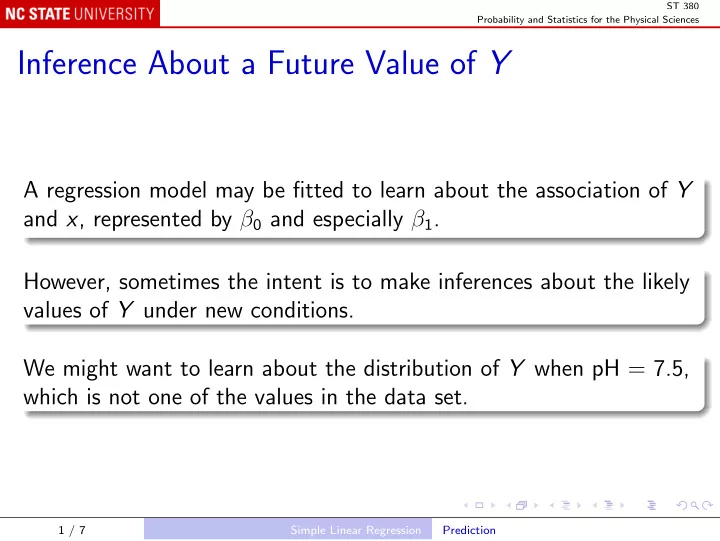

ST 380 Probability and Statistics for the Physical Sciences Inference About a Future Value of Y A regression model may be fitted to learn about the association of Y and x , represented by β 0 and especially β 1 . However, sometimes the intent is to make inferences about the likely values of Y under new conditions. We might want to learn about the distribution of Y when pH = 7.5, which is not one of the values in the data set. 1 / 7 Simple Linear Regression Prediction
ST 380 Probability and Statistics for the Physical Sciences In the regression model, when x has some new value x ∗ , E ( Y ) = β 0 + β 1 x ∗ , so the natural estimator of E ( Y ) is Y = ˆ ˆ β 0 + ˆ β 1 x ∗ . Y ) = β 0 + β 1 x ∗ = E ( Y ), so ˆ We can show that E ( ˆ Y is an unbiased estimator of E ( Y ). To construct confidence intervals for E ( Y ), we need the standard error of ˆ Y ; the formula is known, but using software is simpler. 2 / 7 Simple Linear Regression Prediction
ST 380 Probability and Statistics for the Physical Sciences In R arsenicLm <- lm(Percent ~ pH, arsenic) predict(arsenicLm, data.frame(pH = 7.5), se.fit = TRUE, interval = "confidence") Output $fit fit lwr upr 1 55.01145 50.67454 59.34837 $se.fit [1] 2.045806 $df [1] 16 $residual.scale [1] 6.125584 3 / 7 Simple Linear Regression Prediction
ST 380 Probability and Statistics for the Physical Sciences In the R output, fit is ˆ Y , and se.fit is its estimated standard error. lwr and upr are the endpoints of the confidence interval for E ( Y ), by default the 95% confidence interval. 4 / 7 Simple Linear Regression Prediction
ST 380 Probability and Statistics for the Physical Sciences Predicting the Future Value of Y Note: E ( Y ) is the expected value of Y when x = x ∗ ; in the example, it is the capability of the process to remove arsenic from water with a pH of x ∗ = 7 . 5. Sometimes we need to predict the observed value of Y in a future experiment with x = x ∗ . Since Y = E ( Y ) + ǫ and E ( ǫ ) = 0, the best predictor of Y is still ˆ Y . 5 / 7 Simple Linear Regression Prediction
ST 380 Probability and Statistics for the Physical Sciences But V ( Y − ˆ Y ) = V { [ Y − E ( Y )] + [ E ( Y ) − ˆ Y ] } = V [ Y − E ( Y )] + V [ E ( Y ) − ˆ Y ] = σ 2 + V [ ˆ Y ] . The prediction interval for Y is also centered at ˆ Y , but is wider than the confidence interval. 6 / 7 Simple Linear Regression Prediction
ST 380 Probability and Statistics for the Physical Sciences In R The same predict() method is used, but with an option to make the interval appropriately wider: predict(arsenicLm, data.frame(pH = 7.5), interval = "prediction") Output fit lwr upr 1 55.01145 41.32072 68.70218 Note that the prediction interval has a width of 27.4, whereas the confidence interval has a width of 8.7. 7 / 7 Simple Linear Regression Prediction
Recommend
More recommend